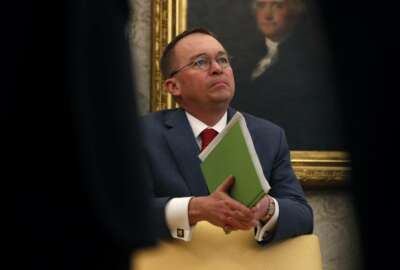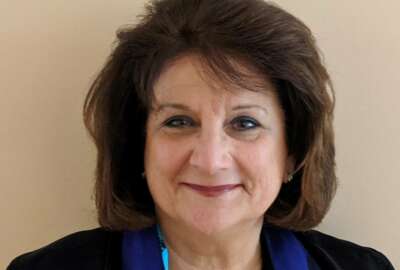
Dedicated feds behind the scenes made major trade agreement possible
Earlier this year a trillion-dollar new trade agreement was signed. It wasn't the politicians that figured out the details. It took a dedicated team of career feds.
Best listening experience is on Chrome, Firefox or Safari. Subscribe to Federal Drive’s daily audio interviews on Apple Podcasts or PodcastOne.
Earlier this year Congress passed and the president signed a trillion-dollar new trade agreement with Canada and Mexico. You might ask how’d they do that? It wasn’t the politicians that figured out the thousands of details. That took a dedicated team of career feds. In this case, John Melle and María Pagán of the Office of the U.S. Trade Representative. Both are finalists in this year’s Service to America Medals program. John Melle is the assistant U.S. trade representative for the western hemisphere, he joined Federal Drive with Tom Temin to talk about their work.
Interview transcript:
Tom Temin: Mr. Melle. Good to have you on.
John Melle: Thanks for having me.
Tom Temin: And you’re an old hand at this and give us an idea of what goes in to crafting one of these agreements, or I guess it takes months and months, that get ready for the politicians to sign off on.
John Melle: Well, the way the United States conducts its trade agreements is fairly interesting because the responsibility is divided between the executive branch and the Congress. So the first part of the process is you have to go to Congress and say, hey, we want to negotiate an agreement and get Congress’s by him that you’re going to do that, of course, you, you ask for permission, but you want to maintain as much discretion as possible to go off and negotiate that agreement. So that’s the first stage of the process. And then we need to get all of our stakeholders on board, the companies that trade, the service organizations, NGOs, labor unions, they have to understand what our goals are and support that process. And then when we are all keyed up, we’ve got to go talk to the foreign governments and they have to be interested and they have to see it as a win for them as well. And of course, they’ve got to manage their politics and their businesses. So it’s an interactive process. You have to be ready to change course or come up with counter proposals throughout this period of time of negotiations. As you says, it does take months. It took us about 14 months to renegotiate an old trade agreement, the North American Free Trade Agreement and we ended up with the USMCA, the US, Mexico, Canada agreement,
Tom Temin: Got it. And with all of those different parties that have to at least have a chance to have a say so, even if they’re not the deciders, it sounds like many, many variables, and it sounds like a lot of transferring ideas from one party to the other, getting by off or alteration and back again, is that part of what takes so long?
John Melle: Yes, that I didn’t even mention the other US government agencies that are involved. All of them, of course, have big stakes in their sectors of the economy and the programs they run. So typically in a trade agreement we will do rounds of negotiation. And for the USMCA, we wanted to do it very quickly. So we began by meeting every fourth week, so quite an accelerated pace, and you’ve got to do all your consultations between those rounds. Again, you have to have new proposals or counter proposals will arrive on your desk from the other country. So it’s quite a dynamic process you go through,
Tom Temin: And there are many commodities involved with all of this. I mean, Mexico makes everything from tequila to automobiles. And ditto for Canada. I don’t know if they make cars up there, but they make a lot of things. And how detailed does it get with respect to products specifically?
John Melle: Oh, it can get quite specific. First to the tarrifs themselves. We did agree to continue with the zero tariffs we had under the NAFTA. But the tariff lines, we’ve got about 12,000 different tariff lines in the United States, and each of them have to be addressed individually. A big concern in our trade with Mexico and Canada, under the prior agreement has been the imbalance that we’ve seen in the auto sector where we run a large deficit with Mexico in autos. And so we wanted to address that by crafting new rules that provide more balance to the auto trade in North America. So a lot of back and forth and a lot of interaction both with the industries which we’re concerned about change, and the other countries that wanted to make sure that they could maintain their industries as well.
Tom Temin: And of course, there’s always tons and tons of documentation. Both of the old agreements and what’s going on with the new agreements? How do you make sure all of that keeps up with what the thinking and decisions are such that when you have a document, it reflects what you actually think you agreed to, and everyone else agreed to?
John Melle: Right well that is the role of the attorneys, the lawyers that attend each of the negotiating sessions. And there’s a lawyer assigned to each of the chapters that’s being negotiated. And my colleague, María Pagán, was the lawyer in charge of all of those lawyers. So she is the one with her team that has to scrub every word, because part of a trade agreement includes dispute settlement procedures. You have to implement it, you have to live up to your commitments, and you can be brought to task if you have not. So words do mean something and María and her team of attorneys were there to make sure that they were clear in what they meant and what the responsibilities are, and provide that language in a way that can be implemented and can be enforced.
Tom Temin: And is there a good system, an electronic system that supports all of that editing and changing?
John Melle: Yes, all of the edits are done on big screens, and you can add your brackets and your highlights. So it’s a pretty iterative process. The actual scrubbing of the text, the last changes were made over the Thanksgiving weekend in that would have been in 2018. So all of that was done remotely on the big screens from various capitals. So the technology has helped us move along and said we completed the renegotiation of the USMCA in 14 months. That’s really record time. And technology is part of the reason for doing so quickly.
Tom Temin: And this strikes me as something that among your personal qualities, you must have to have a great deal of patience and the abilities to assimilate a lot of detail. Is that how you would describe yourself?
John Melle: Yes, I think that’s essential. You can really get down into the details for how a particular sector is to be dealt with — and you’ll have to understand the linkages that either your stakeholders are making or your agencies are making or the other countries are making between that issue and other issues. So there are a lot of balls to juggle. We started out with about 1000 negotiators from the three countries. And we ended up with about 34 chapters in the final agreement, over 2000 pages. So it does cover a lot of ground. But really what it is doing is setting out the rules for trade it is not actually creating the trade itself that’s up to the private sector and the service companies around the world and in the North American region to do that.
Tom Temin: And does it require travel on your part also to get all of these pieces done?
John Melle: Well, we’re in a different age right now. And we are at USTR negotiating with the United Kingdom and doing that virtually, but for the USMCA we were able to travel so typically you would rotate among capitals for each of these rounds. So in addition to actually preparing your texts and counterproposals, you had to do all the logistics to get the right people there. And of course, there’s some negotiation that goes on about who can be in the room and who represents each agency and what’s their role going to be. So a number of different layers that you have to manage to get through this process.
Tom Temin: And despite having all of this patience and experience, Do you ever feel the desire to grab a union member or some industrialist or some government official somewhere by the lapels and say, gosh darn it, shut up and accept this already?
John Melle
Well, I think there’s a little drama in negotiation, a trade negotiation, especially. So yes, you can strategically blow up. Strategically I’ve been blown up at to make a point. But, again, there’s a wide range of behaviors that go on and you try and use them effectively at all times.Tom Temin: And you’ve been doing this a long time. Your work goes back to the NAFTA agreement during the Clinton administration. I imagine it’s also a opportunity in a career to collect a lot of friends around the world too?
John Melle: Well, yes, I think one of the greatest thing about doing international trade negotiations is by and large, our trade agreements reflect US law and US practice. But the other countries have to agree to it. And so it’s a great way to show leadership in the world and to create allies and partners going forward through a trade agreement.
Tom Temin: But I meant personally, you must have people that you may be butting heads with or negotiated with in years past, and when it’s all done and signed, they kind of stick with you.
John Melle: Well, of course, you’ve got some real friendships that you make. And then there are some people, you know, you just really didn’t hit it off with and when the negotiation ends so does that relationship. But yes, I do have friends around the hemisphere and in my case that when you go through a baptism of fire, there’s a certain binding that goes on as part of a trade agreement.
Tom Temin: Sure. And now you have retired I guess as of earlier this year. What are you doing now?
John Melle: Well, I had hoped to travel to parts of the world I didn’t cover during my trade agreement years, but life has taken a different chance. So I’m learning to cook and learning to spend more time exercising and taking care of myself, which is something that does suffer when you have an intense job with the government.
Tom Temin: Sure. Well, let’s hope you get to hop on that clipper to Asia and get to do that one of these days. John Melle is the Assistant US Trade Representative for the Western Hemisphere. Thanks so much.
John Melle: Thank you, Tom.
Copyright © 2025 Federal News Network. All rights reserved. This website is not intended for users located within the European Economic Area.
Tom Temin is host of the Federal Drive and has been providing insight on federal technology and management issues for more than 30 years.
Follow @tteminWFED





